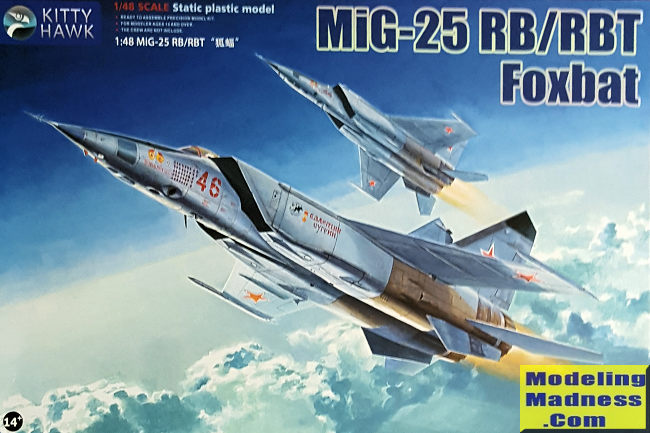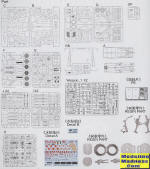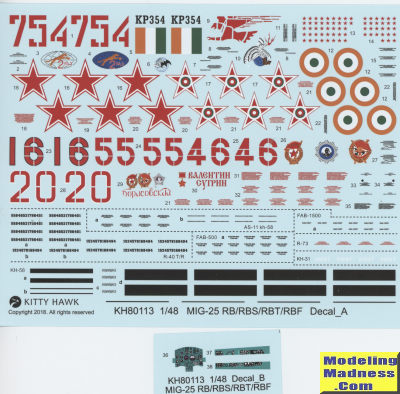
KittyHawk 1/48 MiG-25 RB/RBT Foxbat
| KIT #: | KH 80113 |
| PRICE: | $ |
| DECALS: | Five options |
| REVIEWER: | Scott Van Aken |
| NOTES: | 2018 release |

| HISTORY |
The Mikoyan-Gurevich MiG-25 (Russian: Микоян и Гуревич МиГ-25; NATO reporting name: Foxbat) is a supersonic interceptor and reconnaissance aircraft that was among the fastest military aircraft to enter service. It was designed by the Soviet Union's Mikoyan-Gurevich bureau and is one of the few combat aircraft built primarily using stainless steel. It was the last plane designed by Mikhail Gurevich before his retirement.
The first prototype flew in 1964, and the aircraft entered service in 1970. It has an operational top speed of Mach 2.83 (Mach 3.2 is possible but at risk of significant damage to the engines) and features a powerful radar and four air-to-air missiles. When first seen in reconnaissance photography, the large wing suggested an enormous and highly maneuverable fighter, at a time when U.S. design theories were also evolving towards higher maneuverability due to combat performance in the Vietnam War. The appearance of the MiG-25 sparked serious concern in the West and prompted dramatic increases in performance for the McDonnell Douglas F-15 Eagle then under development in the late 1960s. The capabilities of the MiG-25 were better understood in 1976 when Soviet pilot Viktor Belenko defected in a MiG-25 to the United States via Japan. It turned out that the aircraft's weight necessitated its large wings.
Production of the MiG-25 series ended in 1984 after completion of 1,190 aircraft. A symbol of the Cold War, the MiG-25 flew with Soviet allies and former Soviet republics, remaining in limited service in several export customers. It is one of the highest-flying military aircraft, one of the fastest serially produced interceptor aircraft, and the second-fastest serially produced aircraft after the SR-71 reconnaissance aircraft that was built in very small series compared to the MiG-25. As of 2018, the MiG-25 remains the fastest manned serially produced aircraft in operational use and the fastest plane that was offered for supersonic flights and edge-of-space flights to civilian customers.
Not surprisingly, the aircraft was built as a dedicated reconnaissance platform. This kit allows you to build the MiG-25RB, which incorporates a bombing system allowing the carriage of 8 500 kg bombs. You can also build the MiG-25RBT, which adds in an ELINT capability.
| THE KIT |
 Not
surprisingly, much of this kit is based on their earlier MiG-25 release and I'd
not doubt that a two seat version is in the works. The cockpit is well appointed
with photo etch for a seat harness. The tub side consoles are separate as is the
instrument panel and you have a photo etch main panel supplied. You also
have decals for the instrument and consoles. There are two panels, but you only
use one. The instructions talk about a PD and PDS, but those are not appropriate
for this kit.
Not
surprisingly, much of this kit is based on their earlier MiG-25 release and I'd
not doubt that a two seat version is in the works. The cockpit is well appointed
with photo etch for a seat harness. The tub side consoles are separate as is the
instrument panel and you have a photo etch main panel supplied. You also
have decals for the instrument and consoles. There are two panels, but you only
use one. The instructions talk about a PD and PDS, but those are not appropriate
for this kit.
As seems to be more and more common, you are asked to build up the nose gear well, install the gear then trap it and the cockpit in the forward fuselage section. Once again, I'd recommend test fitting to see if the nose gear can be installed near the end of the build. Same for the main gear. The forward bulkhead for the nose section is resin as are the landing gear legs, which I found rather surprising. The intakes use a pair of photo etch pieces for the upper portion of the engine intakes and this section attaches to the nose.
Building then moves to the complete assembly of the main gear well and landing gear. These are installed in the lower fuselage piece along with the rather complex exhaust. You are provided resin burner cans and rear nozzle covers. One then attaches the upper fuselage piece and after a couple of smaller bits are installed. The nose section goes on. Since the intake doors are closed, there is no need for any trunking detail.
Then one begins attaching flight surfaces. Wings have separate ailerons and flaps with the ailerons shown as drooped. You can also pose the speed brakes extended if you wish. The nose has a resin rear bulkhead and a resin camera assembly. A second nose has neither of those, but they are different and the instructions are moot on which one to use for which marking option. However, you can tell from the painting guide which is on which plane. No indication of nose weight is provided so I'd do a test or two before gluing on the noses or simply add 10-15 grams to be sure.
 A goodly
number of weapons are included with the instructions showing mostly air to
air missiles. Since these were both upgraded with strike capabilities, I'm not
sure if anything other than bombs would be appropriate though I'm sure they
carried missiles for self defense. The assembly of the bombs and racks are not
shown in the instructions. Personally, I'd check the 'net for photos though a
load out diagram is provided. You are also provided with a pair of resin pilot
figures.
A goodly
number of weapons are included with the instructions showing mostly air to
air missiles. Since these were both upgraded with strike capabilities, I'm not
sure if anything other than bombs would be appropriate though I'm sure they
carried missiles for self defense. The assembly of the bombs and racks are not
shown in the instructions. Personally, I'd check the 'net for photos though a
load out diagram is provided. You are also provided with a pair of resin pilot
figures.
Five markings options are provided and once again, you will have to remove the staples from the instructions to get a complete fore and aft set of markings options save for the centerfold. There are three Russian planes with one in camouflage. The other two are from India and Bulgaria. All these drawings show centerline and inner pylons loaded with bombs with twin missile launchers on the outer pylon. Decals are very nicely printed and past experience has shown they are very thin. You get full weapons/pylon data markings as well as stencils for the main airframe.

| CONCLUSIONS |
Like Kitty Hawk's earlier Sukoi kits, this will build into a rather large aircraft. It is nice to see the recce version being kitted as these variants are frequently ignored by kit manufacturers. It helps that a lot of nations flew the 25R types and now you can add one to your display shelves.
| REFERENCES |
https://en.wikipedia.org/wiki/Mikoyan-Gurevich_MiG-25#Reconnaissance_and_strike_versions
November 2018 Copyright ModelingMadness.com Thanks to Glen Coleman and Kitty Hawk for the preview
kit. You can find yours at your favorite retailer. If you would like your product reviewed fairly and
fairly quickly, please
contact
the editor or see other details in the
Note to
Contributors.